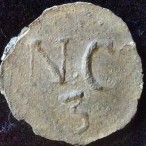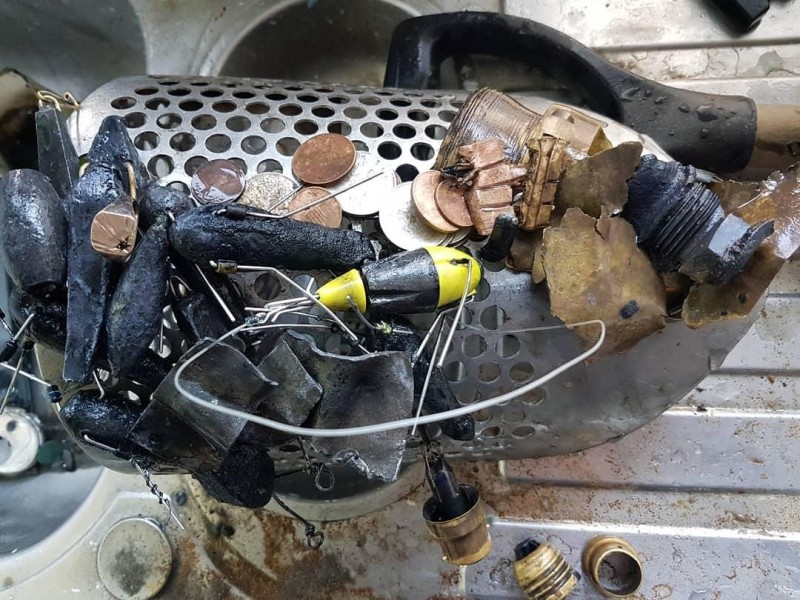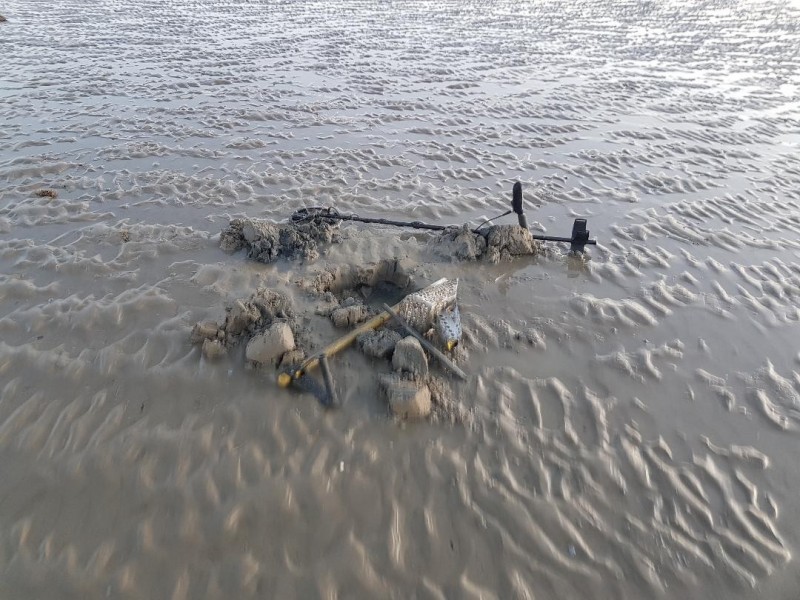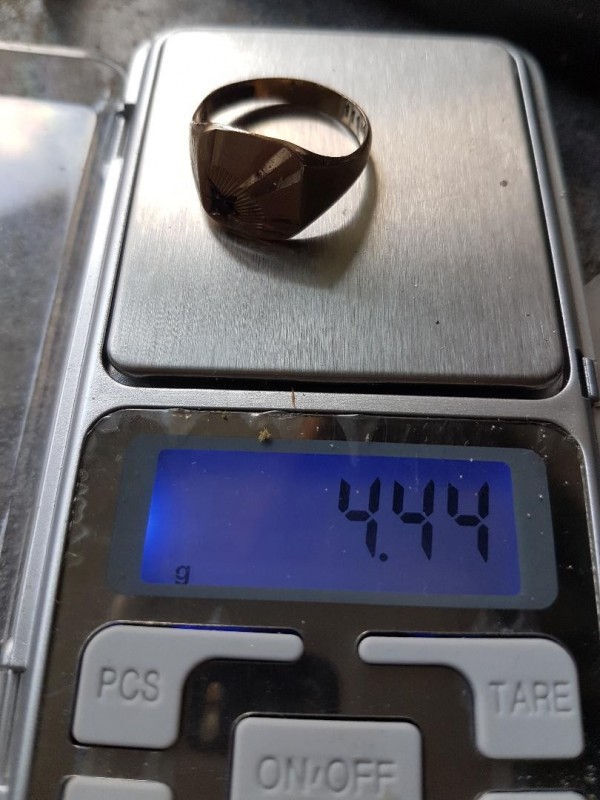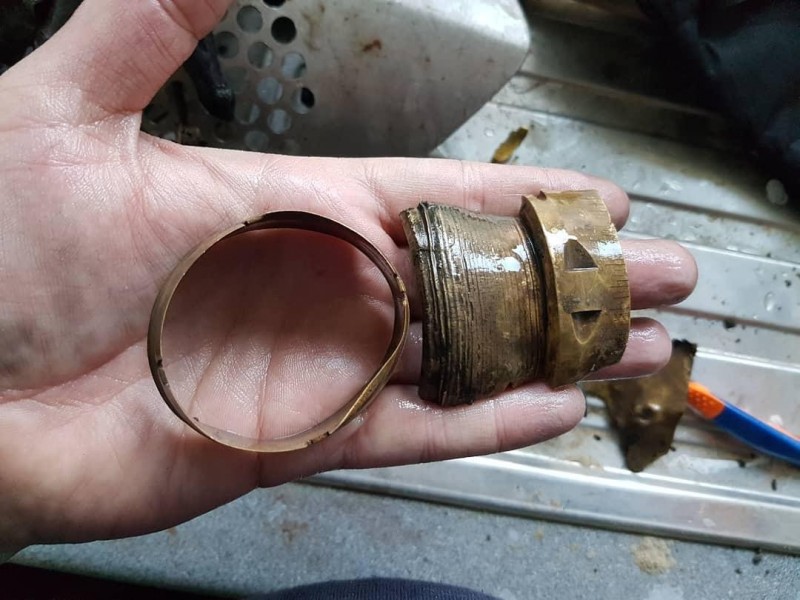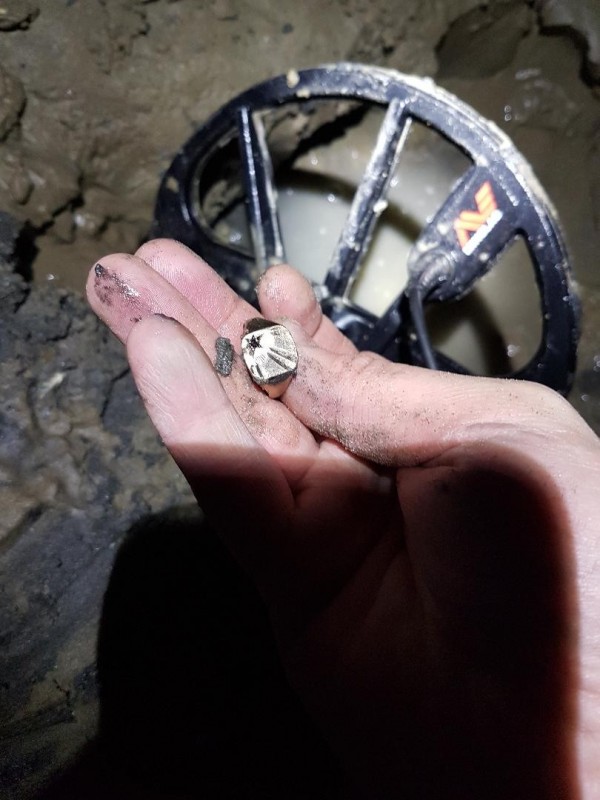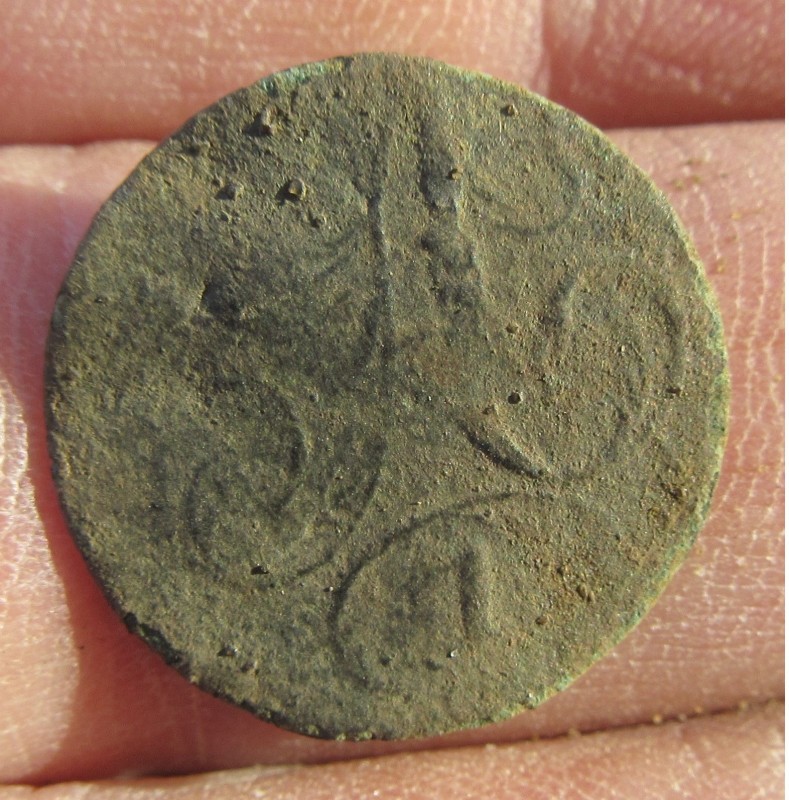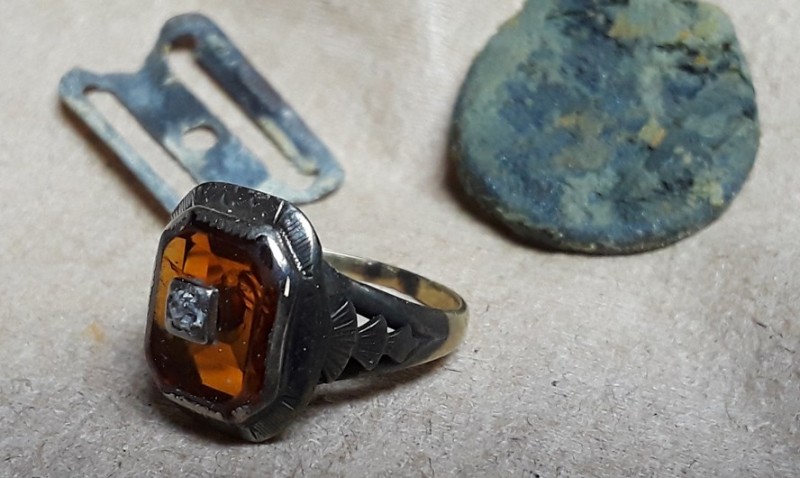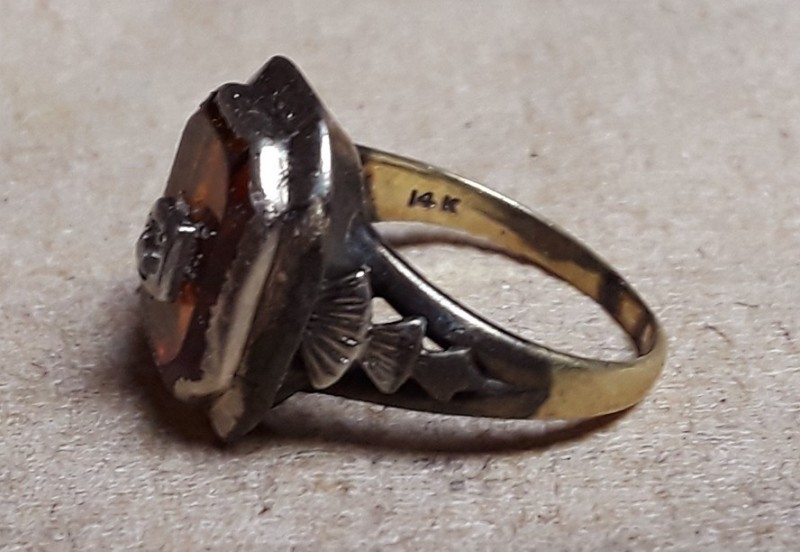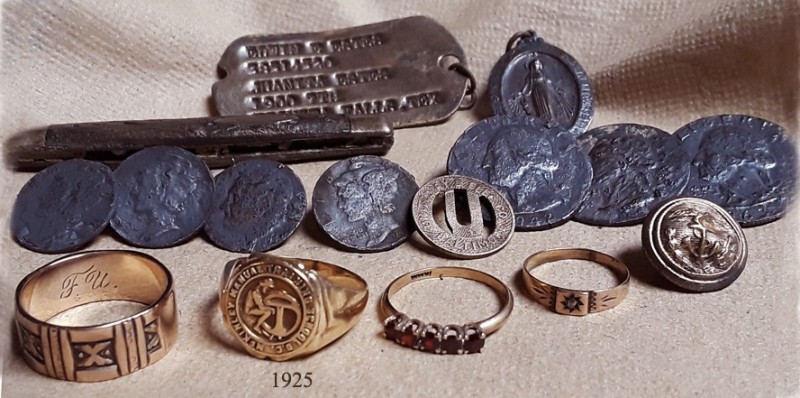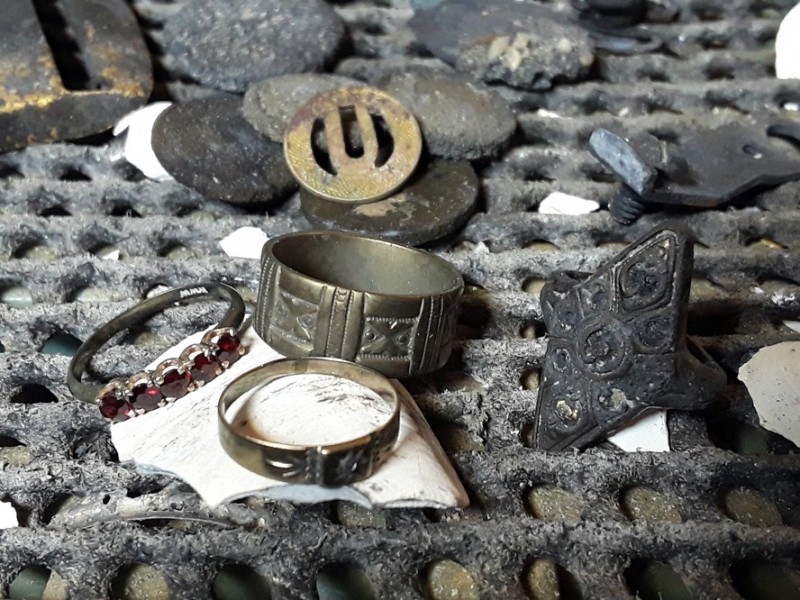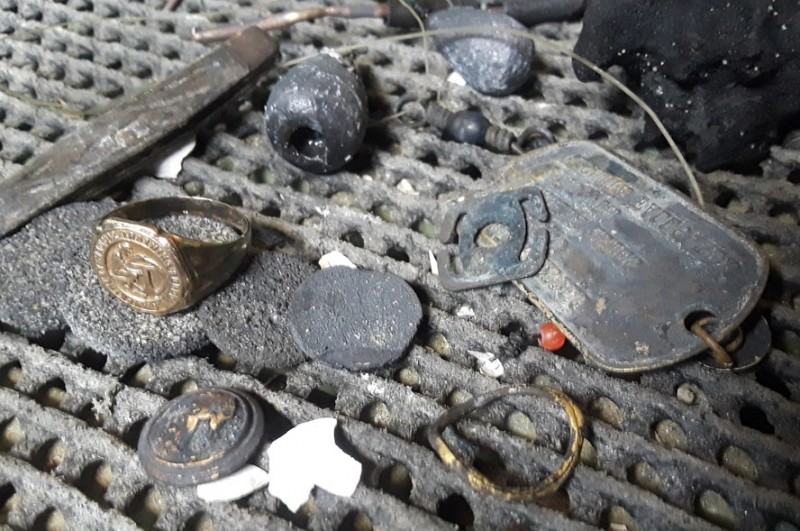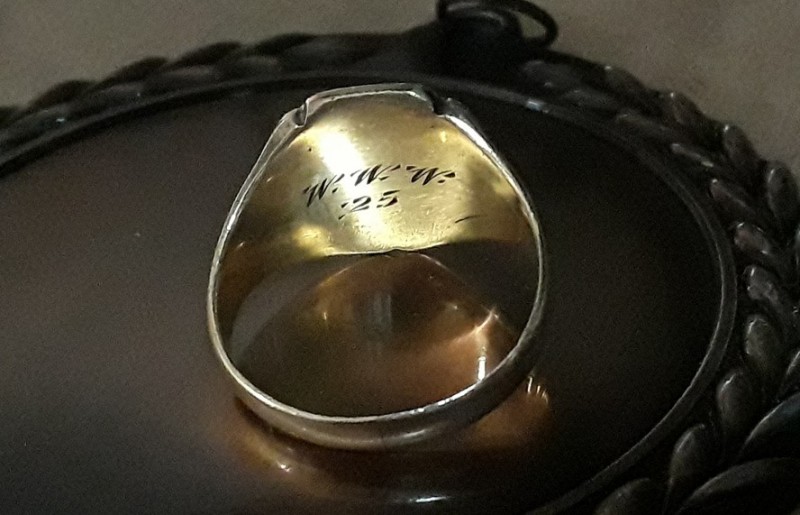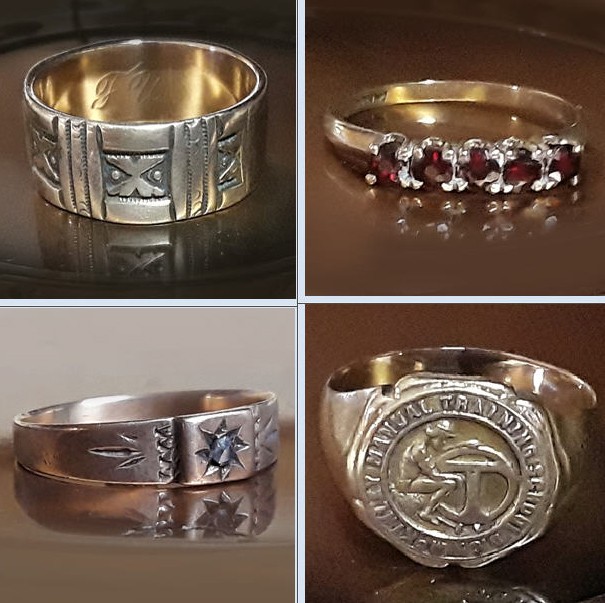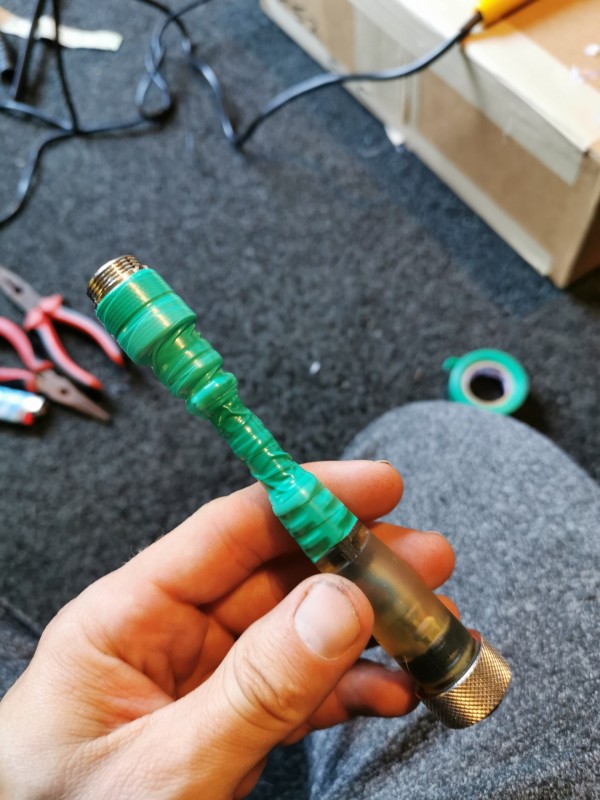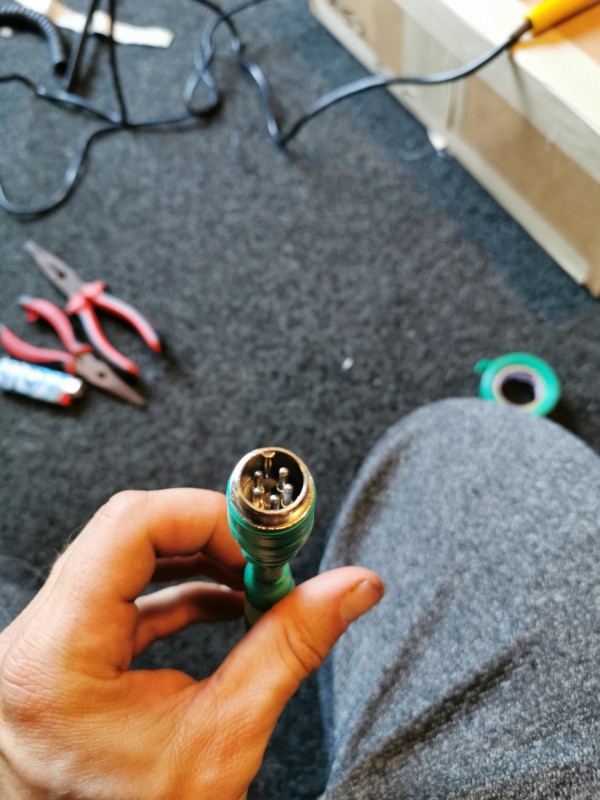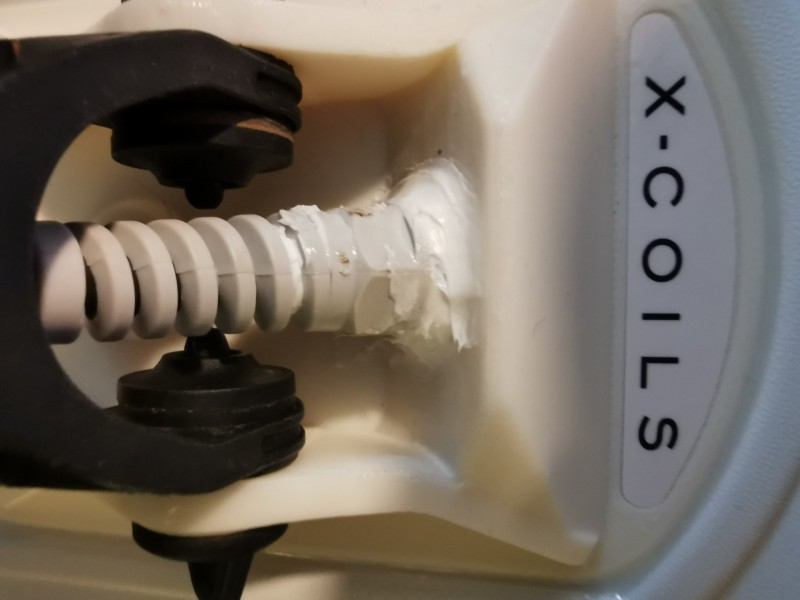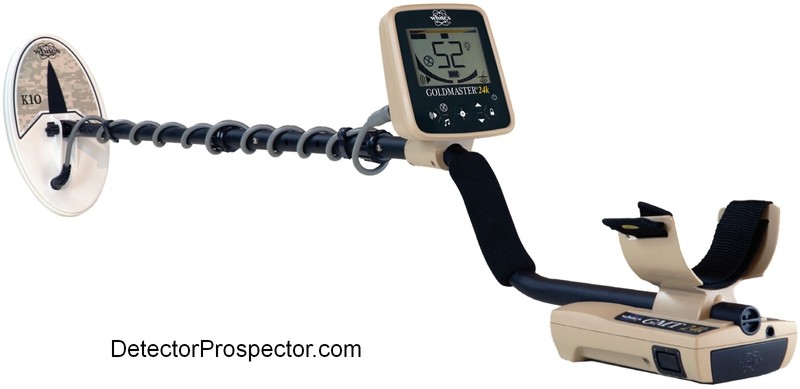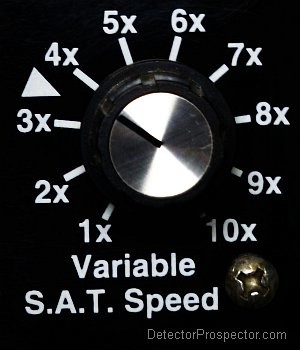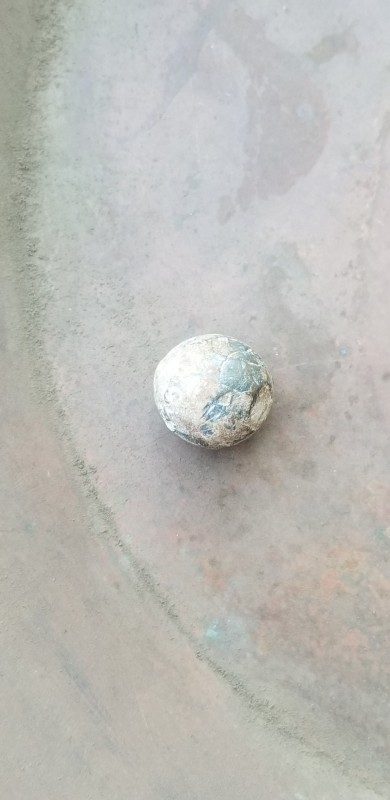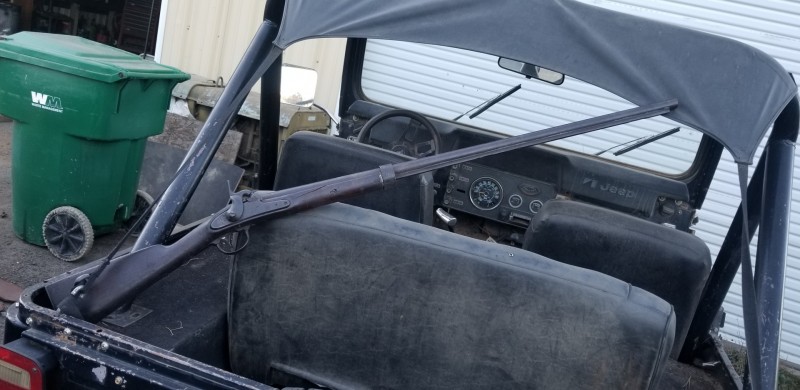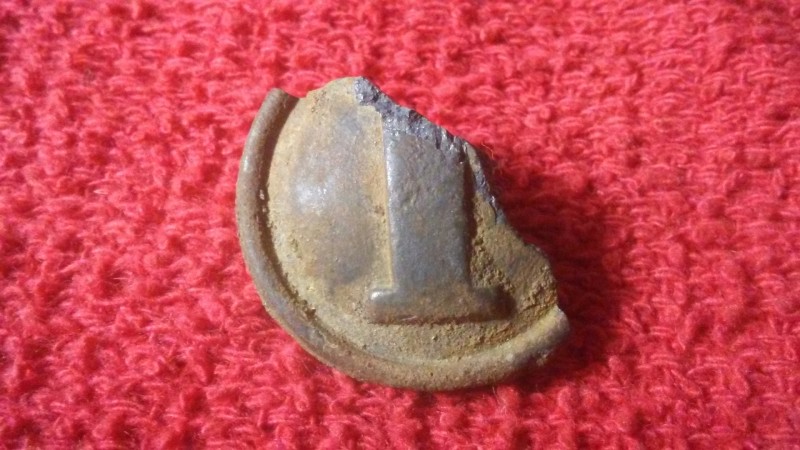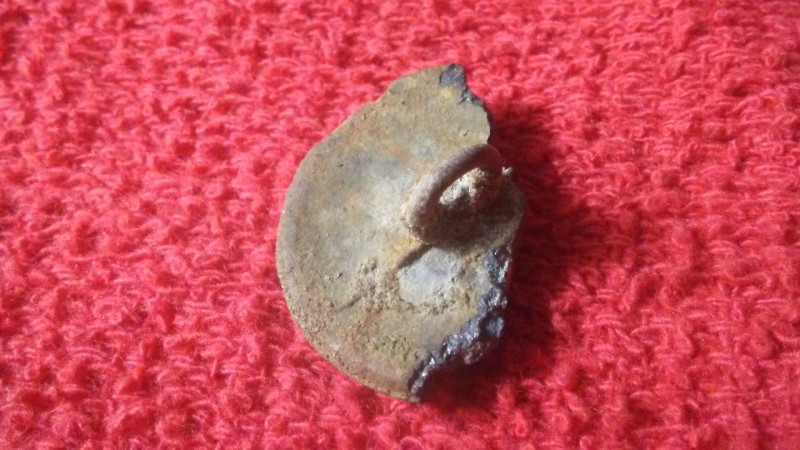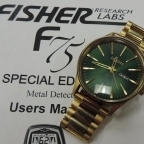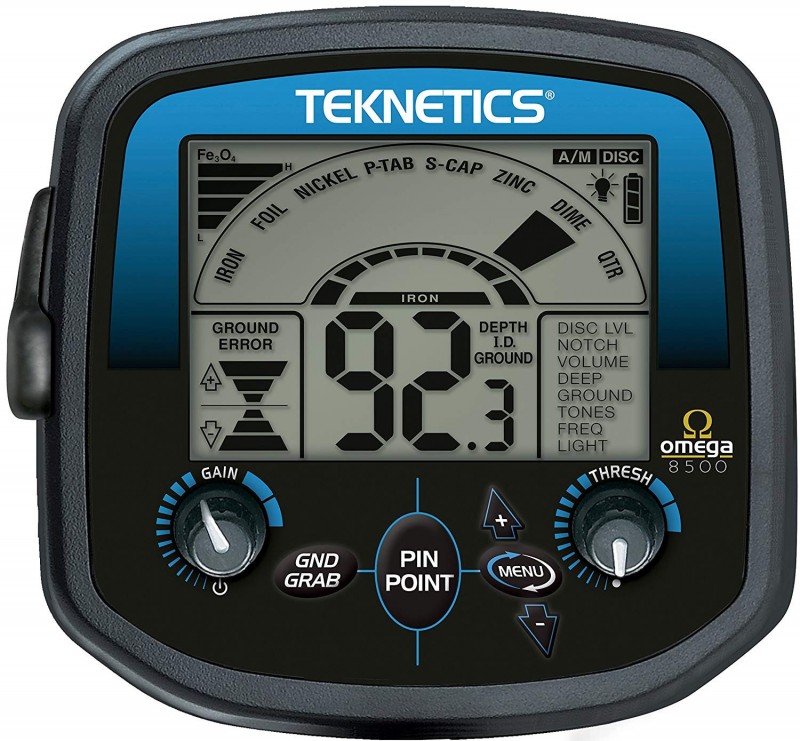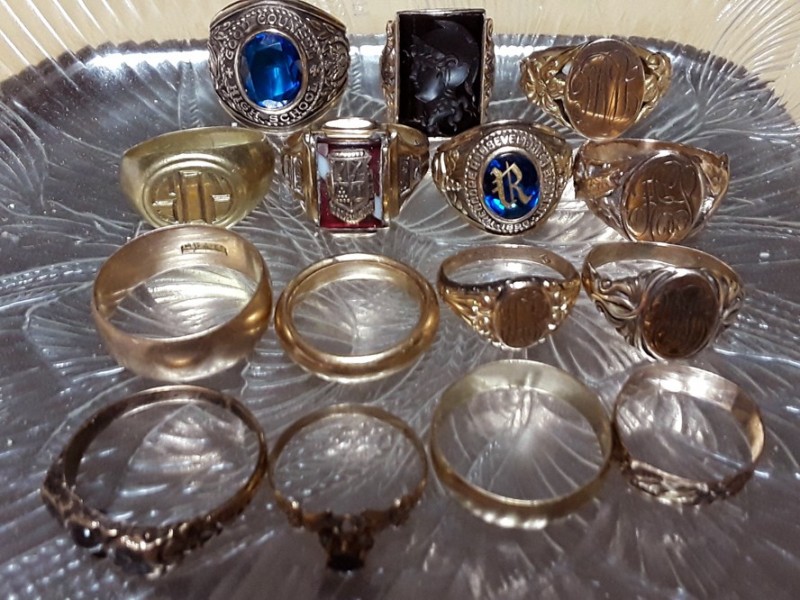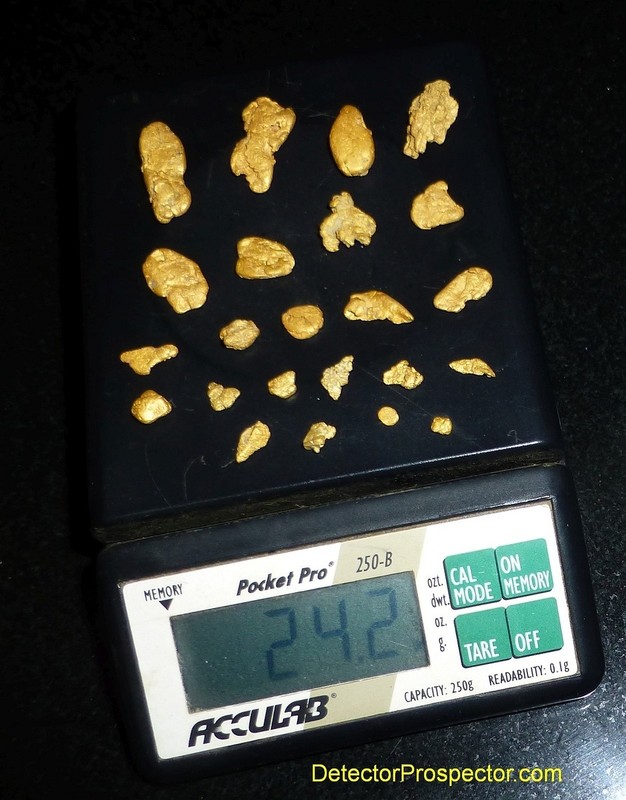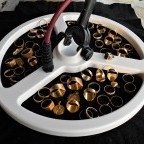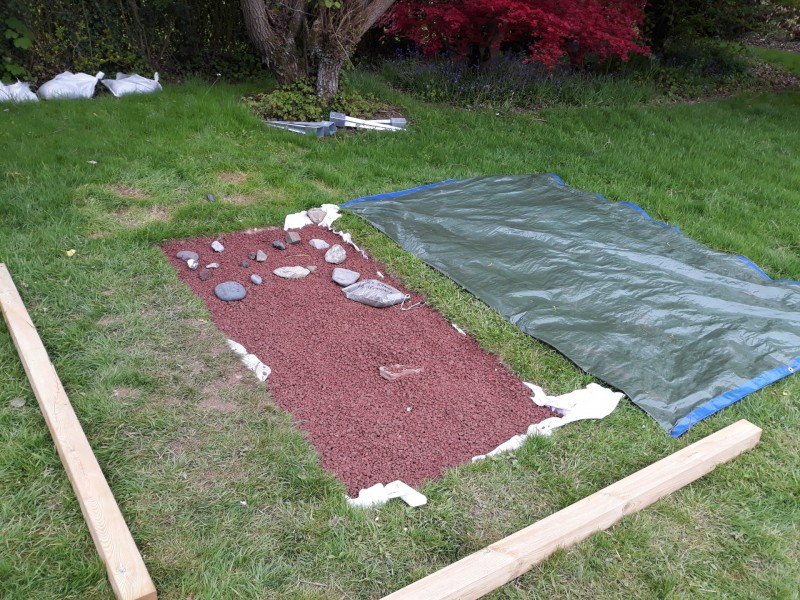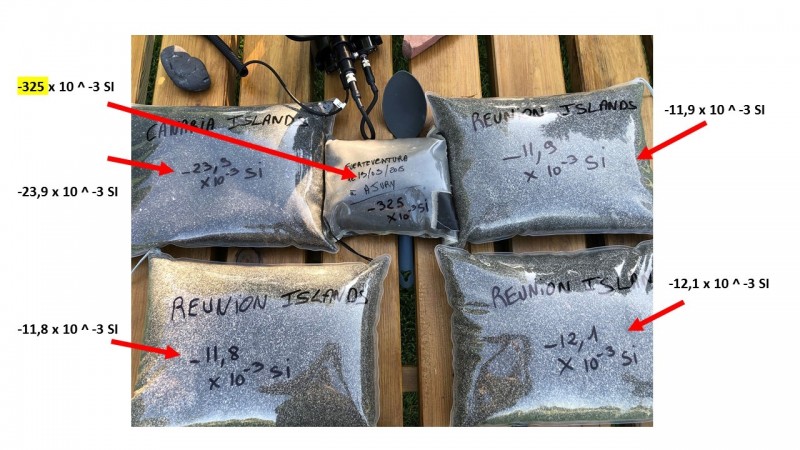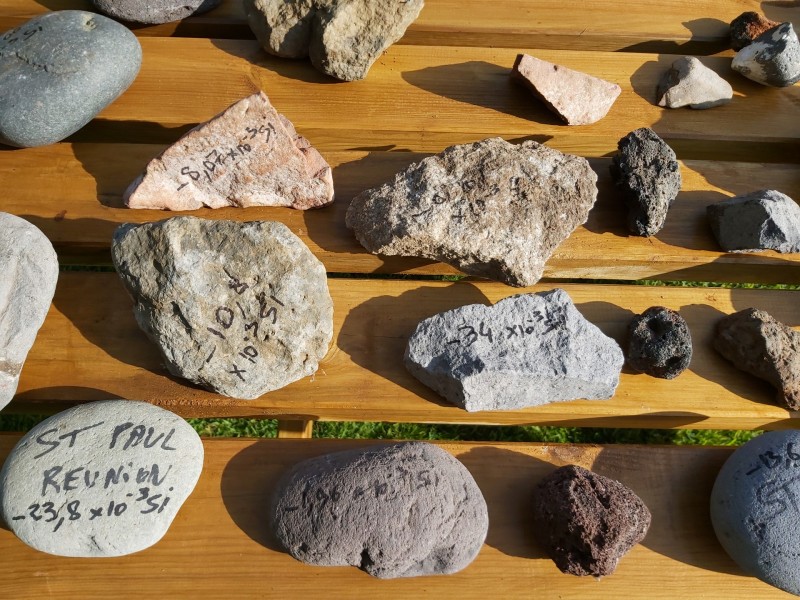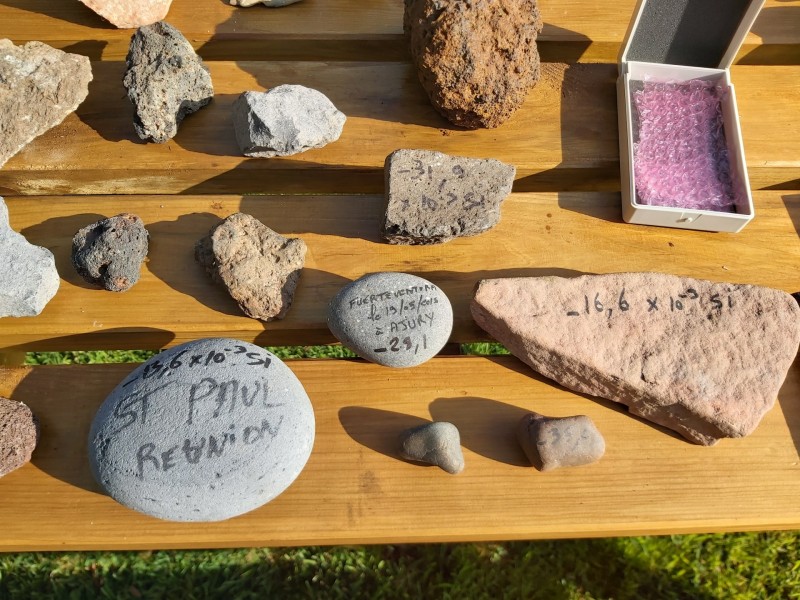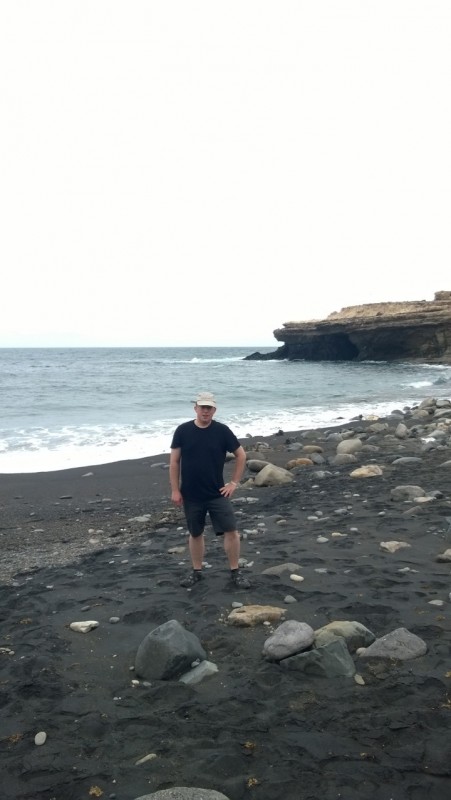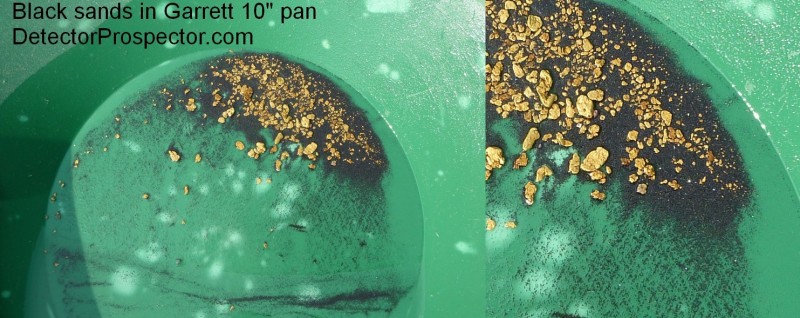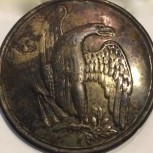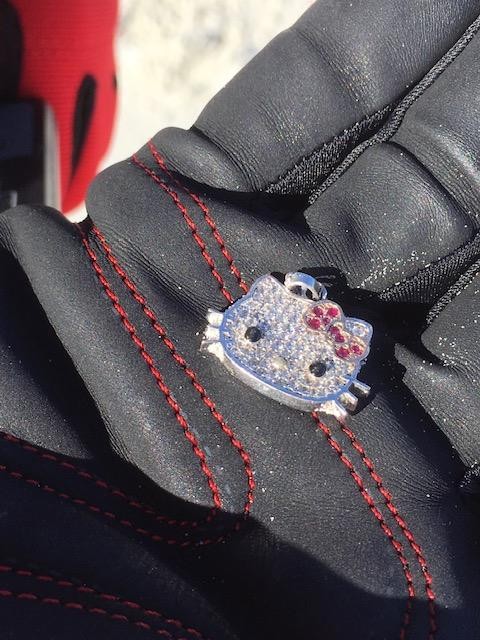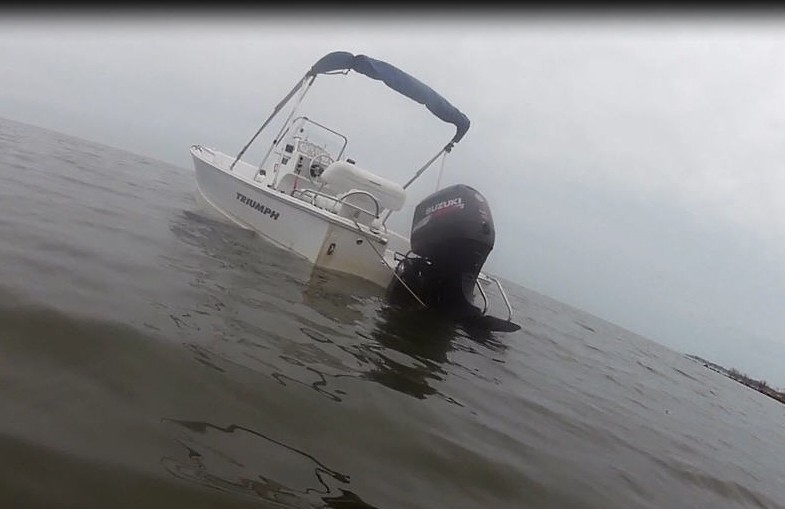Leaderboard
Popular Content
Showing content with the highest reputation on 02/12/2020 in all areas
-
7 points
-
Hello to all was was away in Vietnam for 3 weeks weeks eating and discovering the country but the crave for beach combing pushed me to schedule all my shifts straight at work then head to the coast. A Strom is battering the UK at the moment but i wasn't really interested in that i had my eyes on a beach which i think has been ignore for a while......not a really good access as the road isn't maintained and i dont have a 4x4 so i need to be careful if i dont want to leave most of my car there😅 So i took my nox which i swap for my CTX in January and headed to the spot at 5 am. Signals started straight away with big lump of brass, then i started to pick up fishing weight one after another then i hit Gold with this nice 9ct 4.45gr alas 9ct.....😪 Then few holes later my DIY unbreakable shaft broke but i brought a super dupa spade so i headed to the car and after a water refill(Was sweating despite the strong winds and low temp) i carried for another 2 hours finding the biggest anti aircraft shrapnells i ever found ,imagine been hit by that.The fishing weight are apparently 70/80s.....and the deus shaft you see on the picture of the broken shaft was actually the one i put inside to reinforce Anyway please find the result in picture,i think that that beach has much to offer will try to do another or two long session with the Nox then i will hit it with the PI.....if i succeed it will means 1 thing...my tenacity has paid off or maybe i am just getting to know the beaches better.............. Enjoy RR7 points
-
Over the weekend digs. First day(Saturday) I hit a 1890s homesite, it dates 1890s to 1930s, then next day(Sunday) went and hit one of my colonial site that I been hitting for a while.Script A, war of 1812 button, V-nickel, Sunday school pin, few flat buttons and other goodies. Script A, war of 1812 button 1908 V-nickel. Sunday School pin Few flat buttons Spoon handle Everything. Old trigger guard with some rusty iron.7 points
-
5 points
-
3 points
-
Yes, I want to see more patches come back to life as they have for JW! I've just had my initial day with it so far and there are many more to come. I've got a couple of days lined up with friends so I thought I'd make the same offer to forum friends. All days out in the field are enjoyable and finding some yellow pieces makes it more so sometimes. Mitchel3 points
-
I already have in my mind all mods to transform it in a good dive machine. Believe me, the biggest question right now for me, still remain how to use seriously a 7Ms delay in saltwater. I'm able to remove small copper plated iron cents on my TDIbh misadjusting the GB and to leave gold safe under big coins that I don't dig. (Thanks Steve!). The threshold drift at 10Ms is sometimes a pain however, even with sensitivity on 70% and in really shallow water. Hopefully a stable threshold will be the key for this machine. I know the ferrous/non ferrous target separation is at it's best due to the videos. Now I only need to test one of the first that will be here in Europe to sleep in peace😁3 points
-
As much as I love the Gold Monster, the 24K audio in both all metal VCO and discrimination two tone modes, the XGB ground balance options, the iron cancel options, the threshold tone options (a really big one for me!) and the "to die for" digital backlit display along with that super hot 6.5" coil make it a better choice for me.3 points
-
Craig, right now White's is using all of their 6 by 4s in the promotion for the GMX. The demand for the GMX has been greater than expected, thus 6 x 4's are in short supply. It might be a couple of weeks before they are available publicly. I have one of the first ones and absolutely love it! Just be patient bro. HH Jim2 points
-
I'll cautiously throw in on this since I live in S. CA and have been hunting the beaches out here since the early 1980's. I have used the TDI Beach Hunter and the Equinox 800 extensively. Cautiously since I want to preface this by saying that this is only my experience. The last time I posted a comment about this same subject, on a simple YouTube video, I got torched by PI loyalists. So here goes. From my own experience and observations, the Equinox is every bit the match for the TDI Beach Hunter. Its depth is amazing, as is its sensitivity to small gold. Let me share one experience with you that will prove my point. Last winter, at one of our beaches, a storm had come in and created a huge cut. Several of us hit it hard, a group of about six guys. 4 had Equinoxes, one had an Explorer and I decided to use my TDI Beach Hunter. While I did find a single small gold, I was so busy digging deep iron trash that my buddies were killing me in total gold finds. The reason for this is that the ground balance mode of the TDI Beach Hunter is just a gimmick and really limits your depth. You have to use it as a pure PI to get maximum depth. After several hours of digging trash I gave up and switched to my Equinox 800. My reward: a nice 14K gold chain and a 14K gold signet ring at about 15" down. Again, this is just my experience but if you have an Equinox 600, which you do, and you hunt in beach 1 with the stock coil you will get great depth and you can discriminate. The TDI Beach Hunter does get excellent depth but the "dig all the trash" aspect of it is why I generally stay away from PI's. So my advice would be to keep what you have. I have never used a Garrett Sea Hunter so I can't comment on its capabilities. Bill2 points
-
Daniel, depth is not a problem believe me... You only need to fine tune the machine to obtain a stable threshold with lowest Delay and 70/80% sensitivity. The ground balance can change the sound of objects between low and high conductors. Try a 10 Euro cents coin and slowly turn down the GB to 4/5. At a certain point it will sound like too high (low tone)..Anything under that will be little rusty iron, stainless steel bits and rings, bottlecaps,gold rings and damned 1,2 and 5 Eurocents. There's a way to remove it...but really risky.(You can miss big wedding bands.). All these settings are ONLY available IF and WHERE the water is not that salty and the bottom not that mineralized. Keep in mind, for a real ground balance, the same principle will happen turning up to 7 the GB. So other more conductive coins will be included as lower conductors. The low/hi switch is been removed from the original SL box and on the TDI/BH works this way and only with GB on.2 points
-
So I couldn't resist having a crack at my own adapter soon as my x-coil turned up today. I was pooping my undies on the enitial turn on but all in all wasn't to bad to do it you take your time I started with number 3 blue wire at bottom first as hardest to get to to solder then worked my way up to 2 and 1 the 4 and 5 spent a good 20 mins thoroughly checking for any shorts or anything when I was happy I hot glued all wires and invetween stopping them from being able to move or that in future then heat shrink followed by lots isolation tape I then put the female plug back on the std 14 and works like charm I also waterproofed the xcoil by adding marine silicone in and around the plug and a thin layer along the joining lip were skid plate goes all and all thought for a first attempt wasn't to bad and I didn't make it go boom so that a bonus2 points
-
2 points
-
Ok, I have a working 15x10 X-Coil in Southern California. I'm willing to meet up with someone within a 3 hour drive of Santa Monica (Bakersfield, Arizona border to Yuma) and you can try it on my Z (preferred) or your Z (at your own risk) and see how it performs. We can meet at a place of your choosing (if you want to know how it performs in a specific spot) or we can go to one of many well known spots. I belong to several clubs and I can take a guest. We'll both be detecting and keeping what we find. (No pool and split because I don't know how to divide equally. haha) You can use the X-Coil half the detecting time and I'll use it the other half. If this sounds like a day of detecting for you let me know and we'll see if we can set up a day. Mitchel2 points
-
The two detectors are neck and neck for gold finding capability. The 48 kHz White’s 24K at $729 is lower price out of pocket, but the 45 kHz Gold Monster at $849 comes with two coils and a rechargeable battery pack. If tuned as hot as possible but for stable operation the machines have almost identical performance. It is possible to overdrive the Gold Monster sensitivity to get a slight edge over the 24K, but it comes at the price of the coils becoming unstable and knock sensitive. I like both machines a lot and when I weeded out my collection they both stayed longer than most as I had a hard time deciding which I liked best. After a year of using both I finally sold the Gold Monster and kept the 24K. Why? Ergonomics had a lot to do with it. The 24K comes with an adjustable length rod, the GM a three piece screw together rod. Yeah, you can replace it, but why should you have to? The 24K “S” rod is counterbalanced by the battery pack under the arm, and is more comfortable than the nose heavy GM. The round handle on the 24K fits my hand better than the squared off GM handle. Finally, the 24K stays put when set on the ground and does not roll over like the top heavy GM. Each of these is a small thing in practice but all together add up to a solid ergonomic win for the 24K. The biggie for me however is enhanced options and control. I won’t make a list, suffice it to say the GM was designed for simplicity and as few controls as possible. The 24K on the other hand has a full suite of tuning options including full target id capability, which the GM lacks. I’m a control freak and more than anything else that’s what tipped it for me. The 24K is more versatile. Finally, coils. The GM you have the 5” round DD and 6” x 10” DD. The 24K has the 6.5” round concentric, 6” x 10” DD, 4” x 6” DD, and very soon 8” x 14” DD. To sum up I look at the machines as being a push when it comes to gold finding capability. Give me either and I will do fine and be happy. I recommend the GM for somebody who is control adverse and won’t read manuals. It’s as near automatic as you can get, just don’t overdrive the sensitivity. The 24K offers more versatility for those who thrive on that sort of thing, and along with the ergonomics out of box and extra coil options now I believe White’s has produced an excellent offering in the 24K. In my case at least it’s the one that stayed when the others went away. White’s Goldmaster 24K Data & Reviews2 points
-
What is metal detector “autotune” or automatic tuning? Not automatic ground balancing or automatic ground tracking. Autotune is something so common now it is taken for granted, but it is a key feature when considering how detectors work, especially those designed to work with a faint threshold sound, like most nugget detectors. Prior to the 1980's most detectors had to be ''tuned''. You held them at a fixed height over the ground and manipulated a ''tuner'' until you got a bare threshold sound. A very faint sound you could barely hear. An increase in this sound meant you had a target. You could hold the detector over the target when you found it, and the increase in sound held steady. When the detector was moved off the target, the sound went away. No motion was required to get a signal, and so this mode of detecting is referred to as the ''non-motion mode''. There were two problems. First, the detectors of that day ''drifted''. The faint sound you set would either get louder or fainter. As the machines adjusted to temperature differences, or as the batteries ran down, the threshold changed. It did so rather rapidly, and so you constantly had to adjust the faint threshold setting manually to keep it on that vital edge. Also, the machines of the day could not ground balance. So if you raised the coil you got a false signal. If you lowered it the detector ''detuned'' and the threshold went away. Faint targets were lost. This was mostly an issue with small depressions in the ground. If you had the detector tuned to a fine edge, going over even the slightest depression gave a false positive signal. What I did myself was hold the detector an inch over the ground, tune it, and then lower it to the ground. This slightly detuned the detector and gave up the fine edge, but eliminated false signals from small depressions in the ground. Early 1970s "Mineral - Metal" ttuner control The first solution to this issue was push-button retune. If the faint threshold you had set got too loud or went away for any reason you just pushed a button, and you went right back to the original threshold setting. It was a great advance in its day, as pushing a button was much easier than turning a knob to get back the correct threshold. The detector “remembered” where you set the threshold, and a push of the button instantly returned it to where you had previously set it. This also made for better pinpointing of targets, as you could get close to the target, hit the button to detune the detector, and then zero in on the sharpest signal. Some detectors today still feature this form of ''non-motion pinpointing''. The next advance was electronic. The detector took note of the threshold you set, and circuits attempted to maintain the same threshold level. Since the original idea was to ''tune'' your detector, autotune was born. The detector automatically tuned the threshold. But a side effect was that if you held the detector steady over a target it was ''tuned out'', as the machine sought to return to the ideal threshold level. You had to keep the coil moving over the target to hear it, and so the “motion mode” was born. The original Gold Bug is the best example of all this. It is a pure all metal circuit with absolutely no discrimination. If set in the ''No Motion'' mode you can hold the detector over a target and get a louder sound that does not fade away. The closer you are to the target, the louder the sound. Great for pinpointing. But if you set the Gold Bug in this mode, it drifts. The threshold sound tends to get louder and louder. A Retune button is provided to reset the Gold Bug to the original threshold sound as adjusted by the threshold control. You must hit it about once a minute. The Gold Bug also has an ''Auto Tune'' mode. This is the mode you would normally use. The detector now reads the threshold setting in a feedback loop and keeps it steady. The side effect is that if a target is held steady under the coil, it is ''tuned out'' rapidly. The coil must be kept in motion over the target to get a signal, otherwise the autotune circuitry adjusts it out. It does not matter what causes the threshold to vary. The circuitry just attempts to keep it steady. Nothing is being tuned other than the threshold sound. Finally, there is a "Motion" mode, that is the same as the Auto Tune mode but with no threshold sound (silent search). Fisher Gold Bug controls, with Auto Tune in lower left The Gold Bug is an instructive model because discrimination is not part of the equation and you can see versions of all three basic detector modes at work. Threshold based non-motion mode, threshold based motion (autotune) mode, and silent search (no threshold) motion mode. Here is an excerpt from the Gold Bug manual that describes the three modes in more detail: NO-MOTION MODE: This is the most difficult mode to use. It is more prone to false signals, requires more retuning and must be re-ground adjusted more often than the other modes. However, the search coil does not have to be in motion for target response so it's the preferred mode in tight spots or situations where you just can't keep the coil moving back and forth. Furthermore, the problems of tuning, ground adjust and false signals lessen considerably at lower sensitivity levels or in non-mineralized ground. The No-Motion mode is most often used however for precise pinpointing once a target has been located in one of the other modes. MOTION MODE: In this mode the search coil must be moving, at least slightly, to detect a target. This is the easiest mode to use under moderate soil conditions. There is no threshold tone to worry about so you don't have to use the THRESHOLD control or listen to a constant hum. It's more sensitive than the Auto-Tune and doesn't require retuning like the No-Motion mode. On the other hand, the Motion mode is more sensitive to electrical interference and it's harder to identify false signals and bad targets (hot rocks, ground minerals, trash). AUTO-TUNE MODE: Also a motion mode requiring at least slight coil movement. Target response is smoother than in the Motion mode and, with practice, it's easier to tell the difference between nuggets and hot rocks and there are fewer false ground signals. Since most nuggets are found among hot rocks in extremely mineralized soil this will be the mode of choice for many nugget hunters. Various detectors were introduced with these features. What varied was the rate at which they autotuned. A slow autotune meant that the detector would not adjust as rapidly to variations in the threshold sound. The slow autotune had less of a tendency to ''tune out'' small targets or very deep targets. A fast autotune was more forgiving of variations in the way the detector was operated, in particular as regarding the distance of the coil over the ground and false signals, but is more prone to tuning out very small or very deep targets. Whatever autotune rate is chosen, it is a compromise. And what works well in one location does not work so well in another. When nugget detecting became popular a new variable was introduced. Ground mineralization, and more importantly, variations in ground mineralization, was something coin hunters rarely had to deal with. It was something a nugget hunter commonly encountered. Detectors at this time developed the ability to ground balance, or adjust out the ground effect that caused early detectors to give a false signal if the distance over the ground varied. Depth of detection dramatically increased. The ground balance control initially was a manual control, and so could be set for a certain ground condition. Any change in the ground mineralization tended to produce false signals. Autotune once again came to the rescue, as evidenced by its use in the original Gold Bug model. Units with a slow autotune had fewer tendencies to tune out small gold nuggets, or very deep gold nuggets. The downside is they had to be operated very slowly to allow the autotune to keep up with ground variations. Units with a fast autotune could handle variations in the ground conditions better, but had more of a tendency to tune out small or deep targets. Overall depth was usually decreased with faster autotuning but ease of operation increased. Another split in the technology came along. Many detectors, especially coin detectors, opted for a “silent search” mode. This mode eliminates the threshold sound entirely, very much like taking a detector with a threshold control and turning the threshold down until it cannot be heard. This makes for a quiet machine and became the preferred mode for many coin detectors. But it gives up a fine edge and so top performing units continued to offer a threshold control. Detectors that are silent search units do not need an autotune circuit. You can test a detectors autotune rate on detectors that have a threshold setting by holding a coin under the coil, and noting how fast the threshold adjusts back to its original level. This can vary from a couple seconds to almost an almost instant adjustment. An interesting side effect of autotune is ''overshoot''. If the detector is swept to one side and encounters a target, it attempts to ''tune into'' the target. If the target is a ''positive'' target, in other words the threshold increases, then the autotune circuitry immediately reads the increase and attempts to adjust lower. As the coil passes the target, there is a brief moment of silence as the autotune now has to turn around and increase the threshold back to its original level. In practice, you normally do not hear this. You hear the increase in tone, but not the decrease that follows. The target goes ''beep-beep'' as you swing back and forth over it. The ''beep'' is centered over the target. Move the coin back and forth under the coil and you will hear the sound. Now hold the coin under the coil until the threshold steadies, then remove the coin. The machine will go silent for a short period, again depending on how fast the autotune circuit is. However, if the target is an iron mineralized rock, most commonly a rock with a high magnetite content, then the threshold ''detunes''. The threshold is reduced and goes silent. So as you pass over the hot rock the threshold sound goes silent. The autotune circuit attempts to adjust by raising the threshold sound. But at this point you have passed over the ''negative'' target. A distinctive ''boing'' sound results since the threshold sound is now too high, and the autotune immediately attempts to adjust back down. The ''boing'' sounds occur to each side of the target as you sweep back and forth over it. The quiet spot, or ''null'' at the point between the opposing boings indicates the actual location of the target. To reiterate, autotune creates two types of signals. A beep-beep signal with the beep centered as the coil sweeps over it in both directions. Or a boing-boing signal, with the apparent target dancing back and forth as the coil sweeps over it. The null between the two boings is the actual location of the target, usually a hot rock. When White's introduced the Goldmaster V/SAT it featured "Variable Self Adjusting Threshold" or V/SAT. Self Adjusting Threshold is White's term for autotune. It is a more appropriate term as it explains what is really happening. People tend to confuse autotune with automatic ground balance. Unfortunately, White's fondness for acronyms is such that most people do not know what SAT or V/SAT stands for. The latest acronym is iSAT by Nokta/Makro for "Intelligent Self Adjusting Threshold". White's GMT Variable SAT Control The Goldmasters for many years were the only nugget detectors that allowed you to vary the rate at which the threshold readjusts itself via a knob - anything from very fast to very slow. Only recently has this control become available from other manufacturers. It allows for more control in varying situations. In general, use the lowest SAT setting that allows for smooth operation. As ground variations increase, setting a higher self adjusting threshold can be beneficial. At low settings, the coil can be swept slower. High settings demand a faster sweep rate or the circuit will tune out signals as fast as they are created. The Gold Bug 2 has a “High”, “Normal”, and “Low” mineral modes. These are actually three preset autotune adjustments, with Low being the slow autotune and High being the fastest. Normal of course is in the middle. With the vast majority of the nugget detectors you have no ability to vary the autotune rate. A few programmable coin detectors offer the adjustment but usually relate it more to sweep speed so the detectors can be set for a slow sweep speed or a fast sweep speed. To sum up, it is very important to know how fast your detector is autotuning. If it has a fast autotune and you move the coil too slowly, you will lose very small and very deep targets as the machine tunes out the faint signal before you hear it. Conversely, if your detector has a very slow autotune rate (rare these days, but common on old detectors like the Compass Gold Scanners) then moving the coil too quickly will also cause very small or very deep targets to be lost. The best way to observe this is to bury a target, and sweep the coil over it. Go real slow, go real fast, and try something in between. You will find a certain speed will produce the loudest and sharpest signal. Going much faster or much slower will muffle the target. Detector engineers try to shoot for a normal sweep speed, and newer detectors are much more forgiving than older units. But sweep speed does impact the performance on many detectors. One thing that sets the pro apart from the novice is that the pro keeps the coil moving at the optimum rate that produces the best signal. When autotune is combined with auto ground tracking, this awareness of optimum sweep speed is even more critical. As a rule single frequency machine can handle faster sweep speeds. Multi-frequency and pulse induction (PI) detectors benefit from slower sweep speeds. People used to one type of detector often have a hard time adjusting. It is very common for operators of single frequency fast sweep detectors to swing PI detectors far faster than they should, resulting in significant lost performance. Do not be one of those people. Experiment with your detector to find the optimum sweep speed, and in the case of the few machines that allow for adjustments, experiment to see how slower and faster settings affect the performance. It can make all the difference between finding that gold nugget and missing it. ~ Steve Herschbach Copyright © 2010 Herschbach Enterprises1 point
-
I was out detecting yesterday with the 7000 and found a 69 caliber musket ball. By using the carbon dating app. on my smirk phone and measuring the depth of my dig hole and evaluating the oxidation on the musket ball I was able to determine that it was fired in the Spring of 1857, probably on a Tuesday. I then did science to it by using negative integers of Avogadro's number, exponents of pi and ice cream, calculating sine, cosine, deer sign, tangent and mandarin and entering the data into the 7000s GPS I was able to determine the precise location from which the ball was fired. I entered a track to that location and sure enough I came to an ancient, hollow cedar tree with a limb at the perfect height to rest a musket on for better aim. I then perchance stuck the GPZ into the tree hollow and, not surprisingly, found an 1851 69 caliber Harper's Ferry U.S. issued musket. There may be one or two of you that have doubts about the whole truth of my story but let me assure you that my arithmetic is rarely wrong and the GPZ 7000 is a very capable detector AND Sourdough Scott took photos which I have provided here. I have put a hefty charge of powder in the old thing and hammered the ball down the barrel and I'm waiting for Sourdough Scott to show up so he can have the honor of being the first to fire this piece of history in over 160 years.1 point
-
Yes lots of shrapnel's from anti aircraft coming to bomb London and the are air base no too much dog fights remains I am afraid maybe one day I also been told there is a target pratice in the area with 100s of bullets..................but it is on that beach that I found the 13th century hammered coin so it may have more .................I asked a local detectorist and he told me there was no one in the vicinity well I found one...........but that was with a pulse. RR1 point
-
Here is how I go about deciding what to use. Since you have and Equinox and a Sea Hunter I assume you know when you want to use a VLF for discrimination and when you want to use a PI to dig it all. It sounds like you lean to the dig it all for more depth mentality that leads to using a PI. So for this discussion I am assuming you have decided to use a PI. The question then is whether you need a ground balancing PI or not, which is why I asked about your beach conditions. I have not used the Sea Hunter but have a lot of experience with the White's Surf PI, which is similar. The Surf PI and Sea Hunter do not ground balance. The TDI has a ground balance option, so that is the difference we are exploring. In general with a ground balancing PI you will get the best depth with the ground balance off. Most PI detectors for saltwater detecting like the Sea Hunter therefore have no ground balance. There are conditions you will encounter however where this presents problems. First, in heavy black sand you will find that if you raise and lower the coil off the bottom the machine will signal due to the mineralization. This is a particular problem in heavy waves or when working a very uneven bottom. If you can keep the coil at a perfect distance over the bottom it is no problem as the autotune will smooth the signal, but if you raise the coil off the bottom the autotune can't keep up, so you get a false signal. In heavy waves where you can't keep steady footing raising the coil causes these false signals. If the bottom has lots of troughs and depressions, passing over these areas creates a false signal. The only way to deal with this if you have a Surf PI or Sea Hunter is to detune the detector until the false signals from lifting the coil off the bottom go away. But now you lose depth. Or you can leave the settings more for depth and try and sort the false signals out mentally, but this is very tiring. You can also run into hot rocks, typically basalt or rhyolite rocks embedded in less mineralized beach material. These will give a nice gold ring signal. Again, with a Surf Pi or Sea Hunter, you either detune the machine until they go away, giving up depth, or try and sort them by ear. In either of these situations a ground balancing detector allows you to eliminate the false signals I have described while retaining more depth than would be sacrificed by detuning the detector. The ground balance is basically just a ground notch setting that let's you eliminate troublesome ground signals. Gold rings that read close to the ground balance setting lose some depth. It also creates two tones, one for objects above the ground balance setting and another tone for those below the ground balance setting. Generally on the TDI if you ignore the low tone you will pass on most high conductive coins, large ferrous junk, and possibly very large or exceptionally high purity rings. Digging the high tone only gets the vast majority of rings, aluminum, nickels, and zinc pennies plus small ferrous trash. The dividing point is around zinc penny but it depends on the ground balance setting. See this thread for more details. So if you have having problems with false signals from heavy beach mineralization and hot rocks a TDI may be your solution. If not, you probably won't see much benefit, unless you think you understand and can apply the weird discrimination properties for some advantage. That's just my take on it. I'm perfectly content to use a Surf PI and dig everything in a lower cost more waterproof package than a TDI. Unless I run into conditions like I describe above, which for me were common in Hawaii. Than a ground balancing PI like the TDI can be a good alternative.1 point
-
Your beaches/treasure holes give up an incredible amount of unusual and unending array of beautiful and unique pieces. You are the right man in the right spot. Do you ever cash in? GaryC/Oregon Coast1 point
-
Handsome ring Joe. Good luck with the dry suit repair. Warm and dry is good, especially this time of year. Rich1 point
-
What region are you in? The TDI as a ground balancing pulse induction detector shines in mineralized beach conditions. Volcanic islands for instance. Not so much on coral derived white sand beaches.1 point
-
There are various styles of water hunting. But it can come down to time vs pay off. During recent drop times here in Fl most want to cover as much water as possible thus a VLF.... but in the winter that can all change. Extreme high and low tides GATHER targets or sand is moved which can release a concentration targets. Working an area at that point can be more productive. Some just like digging every target..... but the amount of trash might dictate VLF or PI. Kind of like the Nox....... some just dont want to dig micro/small gold. Thats where a deeper machine could be very useful especially with disc. A few inches can be huge and add a lot of gold for your yearly total. Then ..... there is the cherry picker..... who just digs what he THINKS is gold..... how they do that is beyond me. This machine could give them a problem ....... as well as back problems lol. I think a lot of the good hunters will know even before the purchase of this machine where it might work. The surprise may come IF its disc with great depth over what we are currently using........ then it could become more useful as a daily user than a niche machine.1 point
-
As a separate item? I don’t know. No mention of it on White’s website. Obviously they are making them since they come with the GMX so maybe all it takes is a phone call to the factory. Which I have not done.1 point
-
Same as i use. Met a guy once that cut his down to 4 rake prongs/barbs. I used it and it was a lot easier to use. Unless your the hulk its bloody hard work scraping dirt back with that much surface area. (maybe im just week as pi$$) I do like your magnet idea, i hadnt thought about that.1 point
-
1 point
-
Thanks PPP!... Over the past 6 years I've been very blessed to find one beach each year that gives up 40 to 50 gold rings, then they continue to give but only a few gold here and there. I'm constantly watching them for cuts or openings................. 2019 I found my yearly beach in July, it gave up 38 gold in 15 hunts...then it slowed. Just about then I found two other spots, that had given me several gold previous years had opened again. So those three spots have been giving up the treasure since last July. We have many beach's here in the Bay, most were small and now 98% of them are closed.....I research and find the old beach's, check them out, some give, some give later, some never. I can't wait to get my hands on the "AQ". The excalibur will always be my main machine but after I learn a beach's habits and target history the "AQ" will be the one that pulls the deeper gold and hoping the deeper smaller gold the excalibur can't. It will be a dig all machine for me.1 point
-
Welcome to the forum, Anthony. This is great place for discussing everything related to detecting and for sharing experiences and ask questions. You will find all skill sets and backgrounds here from around the world, from beginners, coin hunters, adventurers, all the way up to professional detectorists who can tell you everything about techniques and machine that are out there. Many of us have found good gold over the years and decades and we all share the passion of prospecting and being out in nature. The Mojave desert is a fantastic place to hunt and it has many known and less known gold areas where you can still find decent nuggets. However, you need to be patient. It took me close to a year to find my first tiny little gold nugget after I bought my very first detector (GB2) many years back. So, be prepared to deal with a lot of frustration at the beginning. Most of the times, we all dig trash in every form and shape imaginable including nails, bullets, casings, wires, tin pieces and thousands of other things that are metal. However, sometimes you also find pieces of value or of historical interest, like coins or spear tips, just to name a few. My single most important advice (other than being extremely patient) is to really learn the inside out of your machine and familiarize yourself with all the settings. Every small piece of trash that you find is a sign that you can find small metal items and this should encourage you. When you have a target, play with the settings before digging it up and learn all the different noises your machine is making. The "golden" rule is to dig every single target (which I highly recommend!), but sometimes the way the detector sounds can give you some clues, especially regarding hotrocks. Also, the GM has an iron meter that can be helpful. But don't rely on it too much as it often can fool you. There is a great youtube video that my good friend Bill Southern put up where he explains everything there is to know about the gold monster: https://www.youtube.com/watch?v=_OJW9HMvQ48&t=658s He also has a great channel that I can highly recommend. Making research is a key component, I use Minecache and USGS geological maps (both in Google Earth) as my main research tools, but there are many other research tools available include books that describe placer gold districts in your area. It is a mistake to just go out in the desert and start detecting (although sometimes you can be lucky). Rather, find out where gold has been found, what deposits there are, when it was found and why, was it lode or placer, what are the associated rocks and minerals that come with it, are there tertiary channels, etc. Alot of these research techniques are described in good prospecting books, I can recommend you some if you like. Good luck and enjoy your machine and your new hobby. I warn you though: once you find your first nugget you will forever be hooked on finding gold . You will start spending ridiculous amounts of money on fancy gold detectors and equipment, you will sit over maps day and night to plan your new trips, you will likely alienate yourself from your family who will fear for your mental sanity, and you will be obsessed for the rest of your life by the magic that gold has. Be warned, you can still go back now! :)1 point
-
1 point
-
You wrote the word great, describing a detector in your post. That makes it more subjective. I'm going to change that word to quality. If you want a quality detector that is not a toy and really works well for under $500, to me Chuck, that depends on how much you plan to detect, where you detect and what your targets are. For me personally, if I was just starting out as a newbie with clear, informed expectations and wanted to turf and field hunt in mild to moderate soil conditions or occasionally freshwater/saltwater beach hunt for less than 20 hours per month total, the two detectors you mentioned would be hard to beat. In more mineralized dry land conditions I would start with the Vanquish 540 or Equinox 600. If I wanted to do a lot of submerged freshwater and a little saltwater wet sand shallow surf hunting I would have to go with the Equinox 600, Simplex, Kruzer, or AT Pro. If I wanted a lightweight, quality detector that was easy to use by anyone for casual hunting, I would pick the Vanquish 540 over the Simplex. The Vanquish is very lightweight feeling and extremely easy to swing. Simplex is a little heavier and young kids (under 11 or so) would have a tough time swinging it for very long. Jeff1 point
-
Hi Carolina, I was the "tester" for the NZ coil, which performs exceptionaly well to the point where I use my Tarsacci 95% of the time...... shared between our NZ west coast black sand beaches, east coast "normal" sand beaches, mud, dirt and water. Yes, I can go into overload on the very very black iron sand, but by running TH0 and Sens 9, tracking.....sometimes Blk sand setting I get results. It just means in places I have to raise the coil a bit higher than normal. Balancing of GB and salt imperative, as is the balancing of other settings. The Tesoro Sand Shark I used never got the same depth, nor did the Sea Hunter Mk2. The GPX5000 just couldnt cope in the same spot as the Tarsacci on the black titanomagnetic iron sand.1 point
-
A stunning result, congratulations, good for you!!! Sounds like you are doing incredibly well with what you have, no doubt about that. A great location and a great hunter will do well with many different detector options. YOU found the jewelry, not your metal detector.1 point
-
search lesson Last week a storm enters that destroyed the coasts, heights of waves never seen, as soon as I calm down prepare my equipment and enter the water, my old and faithful cz with me, I reached the point where by density the metals come together and began their spectacle , 53 rings, 4 chains with medals and 3 bracelets, plus a pair of earrings, total 483 gr in 8 hours of diving at 2.4 meters deep, after putting everything together and taking the photos of rigor, I understood the message "enjoy what you have and what will come" I have already passed the 4 kilos in 3 years detection, made me question if really wanted to change it? Nostalgia takes hold of me and I think of all that he has given me and I have only changed my helmets a couple of times !!! It is like part of my family, I treat it like a Japanese Catalan, I use it clean and I keep it, it goes without saying that it is worth its weight in gold1 point
-
You are completely right Jim! At the time I said that it was from a totally different perspective. In that case I was discussing the reality of target depletion. I was ruminating on the idea of a place like Ganes Creek that was full of ferrous trash and gold nuggets. In the early days there was so much gold that you could use a VLF, skip most of the trash, and get most of the gold. As time passed, all the gold that could get picked with VLFs faded away, and I was forced to go to a PI to “light things back up”. So in that circumstance it made perfect sense to use a VLF first, then go to a PI when I was forced to. On a beach I go the other way. I always use a PI first, and only go to a VLF if the trash levels are too high for me. Yet truthfully there is not a lot of difference between the two situations. So why the opposite thought pattern at work here? I think it is because on a beach I find the digging to be easy and I rarely have run into so much trash that I did not want to use the PI. I also have beach detected mainly on west coast/Hawaii, where a PI has a big edge, and so again I tend to avoid a VLF. Nugget detecting I have used many detectors, but an average machine might be the GPX 5000 with an 18” mono coil. I still love that combo. I am digging much deeper holes, and often in some pretty hard ground. So if the gold pickings are easy I would tend to grab a VLF first, especially back in the old days. The truth is in the world of nugget hunters I was probably in the minority even then. These days I am a PI/GPZ first kind of guy in most circumstances, but still more willing to use a VLF than a lot of hunters I know. Long story short you caught me in an enlightening contradiction that I can only explain by saying from my perspective it is a beach versus nugget detecting thing. For a beach I definitely go PI first and VLF when forced to. And if I look at even my nugget detecting these days that tends to be the case. But if I was going to hit a new area in Alaska scouting tailing piles I have never seen before, I might very well go in first with a Equinox and 15” coil. I would be looking for easy pickings while avoiding the inevitable deep junk. If any area did prove to have gold, I would then bring in the big guns and hit that area hard. For most places in the Lower 48 however I am finding target depletion to be so serious that I have to not only use a PI, but the most powerful machine possible, a GPZ 7000, if I really want to stay in the game. I use a VLF when I just want to find gold, which means the plentiful tiny bits I can find anywhere there is gold. But that is more for fun than real nugget detecting, where the weight does matter. Thanks for pointing that out.... got me to thinking! 🙂1 point
-
I’ve always imagined ground balance and discrimination as “necessary evils”. In other words, if I don’t have to use them, I do not. Both are electronic filters, and their use can cause lost depth and lost targets. The TDI is the best example of ground balance off giving best performance in mild ground, but there are others, like the little known ability to shut ground balance off on the GPX 5000. The thing is, if you use no ground balance, you will run into issues where increasing ground mineralization and especially hot rocks impede depth and create false signals to the point where you are better off engaging the ground balance to get back stable performance. I have found it is the hot rocks especially that are the issue. I can run a PI like a Surfmaster PI or TDI with ground balance off in pretty bad ground as long as the mineralization is even, spread out, homogenous. But toss some hot rocks in mild sand, and the false signals can get overwhelming. Same with discrimination. Digging everything is the only way not to miss good targets, especially the vast numbers of good targets masked by trash. If you don’t dig that trash target off first, that masked target at 4” stays there. It’s not all about depth; there are plenty of good shallow targets in parks masked by trash. But most people hit a wall digging trash. We all usually have time constraints, and digging everything can be counterproductive when all you have is two hours. So I turn on the disc and do the best I can. Therefore my mottos. Use a PI when you can, and a VLF when you have to. Leave ground balance off when you can, but turn it on when you have to. Leave discrimination off, but turn it on when you have to. Each of us has different thresholds for when we are forced to switch methods, and no one methodology can be said to be right or wrong as it just depends on circumstances and personal taste. The main goal is to have fun I think, and so do what it takes to make your detecting fun.1 point
-
Hi from OZ, have used Lunk's settings found gold, did a lesson with JP, used JP's conservative settings found gold. Last season run almost silent threshold max sense finding gold. Next up coming season going to switch from semi auto ground balance and try manual ground balance. Amazing machine, also going to try the SP01. Cheers1 point
-
1 point
-
Wow Joe, An impressive group of finds for the month. This time of year, you're certainly wearing the dry suit when on the jet ski - Have you thought about adding a CAPE to your outfit.? 😁 Something with your Pirate theme would look good. Best of luck for February - Rich -1 point
-
Not a lot of targets for three hours.....First Gold a hematite Intaglio Roman Soldier Ring, I believe this one is dated late 1800's to early 1900's. Second Gold ring a nice 14k monogram signetring early 1900's. 12.5 grams. Water is a chilly 41, air temp 46..with N winds at 23 mph. Had the best January I've ever had with 15 gold rings.1 point
-
The reality of naturally occurring gold nuggets is that the smaller nuggets are more common than the larger nuggets. The larger nuggets are also easier to detect. Unlike jewelry, natural gold except in active placers does not replenish. That means that in order to sell metal detectors the ability to find the small gold that is left is becoming ever more critical. However, if you are prospecting for an actual income, either full-time or more often part-time, as is true for small numbers of people in Australia and the U. S. and in far larger numbers in the third world, there is the reality of diminishing returns. I have run my prospecting as a business licensed for profit operation since 1979, and turned a profit in nearly all those years. I have only shown a loss a few times, typically when making large equipment investments in a single year. In most years I have all my equipment and costs are merely food, travel, etc. Since I work for myself there is no labor expense per se. Yet the hours do matter to me. I am only willing to devote so much time to prospecting and only if it makes a reasonable return or at least breaks even. My cut off point has declined over the years as the price of gold has gone up, and was last set at an average of 1/2 ounce per week or about 2 grams a day, figuring at least 50 hours of detecting in the week. To make this happen I need to be seeing at least half gram and 1 gram nuggets (or larger) turning up now and then. To make it on sub-grain gold I would have to be parked all day in one place using the detector to find tiny bits at a fairly constant rate. I once detected nearly 100 nuggets in one day, all under a few grains, in a 10 foot area. That made my half ounce for the week. The thing is, if that is the situation a washing device like a high banker or dry washer usually makes more sense. There are places where there is a lot of small gold, and rules make using anything but a detector difficult. I have no doubt in Africa some people exist on just the tiny bits, but they live on nothing compared to us. When full time detecting one has to be searching for new ground constantly. There are many days with no gold. So when a few nuggets do get found, they need to be good enough to cover all those non-productive days. Hobbyists on the other hand just want to find gold, any gold. They will spend a great deal of time and money to find a few tiny nuggets. That’s who buys most detectors in the U.S. The problem for me is I am one of the older hard core more serious types. If all I want to do is find stuff for fun I’d as soon go to a nearby park or beach and look for jewelry, and be home for dinner. Real prospecting for me means weeks or months in the field at a time, and lots of work. I have found many pounds of gold nuggets over the years, so simply finding a gold nugget is no real challenge for me. I almost never come home empty handed if I go nugget detecting. However, I am finding it hard to justify the time spent to use a metal detector to find gold nuggets and am slowly shifting more to doing it for fun. Long winded explanation but the bottom line in my opinion is there is a place in the nugget hunting world for a detector that can handle alkali conditions, and that by default means small gold will be lost for reasons we have already covered. Tune out the salt, you lose the small gold anyway. But many gold nuggets do hide in alkali conditions. The other lesson there is that having a salt compensation mode would be very useful on the gold prospecting version of the Impulse.1 point
-
This equates to around a 3.0 grain gold nugget, which for me is plenty small. There are many places in Nevada in particular where there are gold nuggets larger than this and where the ground is not very mineralized with magnetic minerals. There are however large areas where alkali salt really troubles some detectors, like the GPZ 7000 in particular. A detector tuned specifically to work on alkali/salt while still having sufficient sensitivity to small gold may work very well in some gold nugget locations, salt flats in particular. There may be areas where hot rocks prove problematic, but there will be areas I am sure where the Impulse AQ can find gold nuggets. I plan to be one of the first to find out. The photo below has 24 grams of Nevada gold I found with the GPZ 7000, with none of it exceptionally large or small, but all more than the 0.2 grams we are talking about as a cut off point for the Impulse AQ.1 point
-
This is an interesting subject that few people know how to deal with even at the metal detector companies. Impulse AQ must pass over all types of magnetic soil, fe2o3 and fe3o4. On the other hand it will not take small gold nuggets, it is not planned for that. The impulse gold model will be provided for this research ... Impulse AQ does not detect below 0.1 gr / 0.2 gr, however it cuts very very hard this type of ground. Especially in volcanic mode. http://www.zhinstruments.com/sm_30.htm I have enough stones from all over the world to open a stone quarry. I was able to volcanic sand 10 times more intense than the most difficult of my volcanic stones. HERE 325 x 10^-3 SI No problem with AQ :1 point
-
People sometimes misread the term “black sand”. Black sand is a mining term and actually has more to do with weight than color. Black sands are the heavy mineral concentrate recovered when running any form of placer mining concentration system. The most basic version is the heavy mineral concentrate left in the bottom of a gold pan. From the Glossary of Placer Terms in Placer Examination Principles And Practice: BLACK SAND Heavy grains of various minerals which have a dark color, and are usually found accompanying gold in alluvial deposits. (Fay) The heavy minerals may consist largely of magnetite, ilmenite and hematite associated with other minerals such as garnet, rutile, zircon, chromite, amphiboles, and pyroxenes. In Western gold placers, the black sand content is commonly between 5 and 20 pounds per cubic yard of bank-run gravel. Black sands are also concentrated by winnowing action on beaches derived from terrestrial sources like volcanoes or granitic intrusives... any source that can supply the requisite heavy minerals. In this context simply looking at a beach or in a stream and seeing dark or black colored material is not finding black sand. Amateur gold prospectors often do this, thinking that seeing black colored material in a stream is a positive sign for gold. All they are often seeing is just material like black slate or shale gravels and sands, not actual black sand. Unless it is heavy material concentrated by gravity action and typically with a high magnetic component, it’s not black sand in the context of the discussion. True black sands are usually very fine though I have encountered coarse grain varsities. The fine grain variety often has a glittering appearance due to the presence of many sharp edged crystals of the constituent materials, chiefly magnetite. Sands concentrated by gravity action and containing a high enough portion of heavy garnet material which confers a reddish color are referred to as “ruby sands.” Again, the key thing is material derived by gravity concentration and therefore very heavy, not simply color. Here is a picture of some gold I recovered in a Garrett 10" gold pan along with the resulting heavy magnetic black sand concentrates. Click picture for larger view. Placer gold and black sand concentrates1 point
-
I wrote this up awhile back for Kellyco's website but never posted it here for some reason. After posting the story of the Flung Ring return, I thought, why not post this story on the forum since it was one of the most personally meaningful returns of my metal detecting life. Although the returned item was not all that valuable in monetary terms, it was priceless to the lady who lost it and became even more priceless to Mary and me as we put it back in her hands. ~~~~~~~~~~~~~~~~~ My wife Mary and I were spending a nice day at Daytona Beach Pier this past summer..she for painting and me for detecting. While I was hunting the beach, Mary struck up a conversation with a lady she met there. The lady was very pleasant and told her that she and her boyfriend were homeless and lived in a makeshift tent right on the beach. She said the local police leave them alone as they routinely clean up the beach of litter and don’t bother anyone. As the conversation continued, she told Mary that she had lost a sterling silver charm the day before and although she and her boyfriend searched for hours, they failed to find it. The small charm was the head of a kitty with red “ruby” stones on its head and black eyes. The little charm was extremely meaningful to her and likely one of the most valuable items she owned. Mary told her of my metal detecting and asked if she would like me to try and find it. The lady was overjoyed at the prospect but said she didn’t hold out much hope of ever getting her little kitty back. Mary brought me over to the area where the lady said she thought it was lost and I began the grid search. About 10 minutes later I got that familiar exciting high tone of silver. In my scoop was a little kitty’s head with red “ruby” stones and black eyes! When I brought it to her, she began to tear up, thanked me profusely and asked if she could hug me. She called over to her boyfriend who was busy making little items out of palm fronds he sold to tourists. The smile on her face and the tear in her eye was absolutely the best reward Mary and I could have ever hoped for that day. ~The Challenge: Big Beach; Little Coil; Tiny Targets~ ~"Simplicity is the ultimate sophistication"~ Leonardo da Vinci ~Pre-determined settings serve only to get you in the ballpark. It’s up to you to pick the best seat~1 point
-
Very wise words Steve and people should listen, time is passing to fast enjoy the now tomorrow is another day! Recently my wife died, was with her for 37 years and time just flashed by and when you look back it seams only a few years! My motto at this moment is " Live your life in the now, and don't think of the future "1 point
-
Yes, Very careful. I have a long Telescoping Boat Hook I use to check the depth as I'm drifting in...and. I do have a nice ladder off of the back which really helps me slowly get off...and makes for a easy get back on. The boat has been a great tool that has helped me get to spots no one else can being many of the old closed beach's are now private and have no way to get to from land.1 point
-
I've been thinking about it for a while, however to reach low prices it would only be ALL METAL. No magnetic ground effect compensation. I also drew it completely. It would of course have all the settings ... delay, freq, volume, threshold etc ... a waterproof version 60 meters1 point
-
He mentions in the video a couple months for the GMX so maybe same for the coil for some inexplicable reason. NokMak makes all the U.S. manufacturers look like they are mired in a mudhole with a two wheel drive ATV.1 point
-
I think the cleaning of a coin is subject to its rarity and or value. I've personally (when I was younger) removed great detail of patina from a few Large Cents and 1 Flying Eagle. All I used was water and a soft toothbrush. So now for some of my coppers that I really like, it is a soft dry toothbrush and toothpick, as Kac does. I've dug thousands of wheat backs and most are common dates/mint marks. I toss then in a tumbler with fish aquarium gravel, a little water, squirt of Dawn dish soak and let them run 15 to 20 minutes. All I am doing is knocking the crud and dirt off them. Silver, When I was young they were tossed into the tumbler too and boy do they shine. Problem is some silvers are semi and key dates with low mintages. Those need to pampered and soaking in water with a light rinse is all I do. Common Roos, Merc's and Washington quarters are soaked and brushed with toothbrush, but I quit tumbling them, as the shine, in my opinion is not recommended. Nickels, Those pesky dark stained, sometimes purple or red, brown, even black on occasion. If they are common dates, I toss them in the tumbler. Semi dates ones get the water and soft tooth brush. I'll use an eraser on them to add highlights, but I assure you there is abrasive marks left from the eraser. At least the common Buff or V now looks better with a highlight, but that is my coin so I am not worried of value. My 1913-S Barber Quarter (Key date) was dug in Nevada and as most of my 100+ yrs old silvers coming from the desert with high alkali, they come out of the dirt with a crustry gray coating. I have not done anything with it, other than water and tap dry. The actual condition of the coin is F-12 with detail, but the other blemishes and clap on it kills the value and most certainly drops condition. I have yet to decide (and keep going back and forth) on if I should get it professionally cleaned and as stated what makes one a Professional? I guess it depends on the person and what you plan on doing with it. Myself for this coin. If PCSG says cleaning will drastically reduce the value, then I'll probably leave it as is. If they say "after cleaning it will have detail of F-12" and look much better, but will be labeled as "Environmental Damage", and the value will drop a little, then I'll probably get it cleaned. If the value drops 50% or more, I might as well leave it as is. Who knows, but right now it looks like crap to me.1 point
-
I am a Fisher Gold Bug Pro fan. The machine is lightweight, easy to use, and very effective for what it is designed for. However, the Gold Bug Pro is somewhat feature limited and the F19 adds some extra capability that many people would welcome - things like a meter backlight or ferrous volume setting, for instance. The main thing however is that if you want the 10" x 5.5" elliptical coil for the Gold Bug Pro you have to get it as an accessory coil, or buy a two coil package. It is odd to this day that the Gold Bug Pro, a machine aimed at gold prospectors, is not available with the 10" elliptical coil as the stock coil. For this reason I aim people who want that coil at the F19 because you can get it stock with that coil. You get all the 19 kHz performance of the Gold Bug Pro, plus extra features, by getting the F19, and for about the same price as a Gold Bug Pro two coil package. Either way, this 19 khz model in all its flavors is a very solid performer on low conductors like gold and small targets like ear rings or small gold nuggets. The 19 khz platform is a little weak on silver coins but still does very well as a coin hunter. The main thing I like is the light weight, solid performance, and very simple operation. The 19 kHz circuit is also one of the best I have used for ignoring electrical interference in areas where other machines may have issues. Finally, do note that the Fisher F19 is the same unit electronically as the Teknetics G2+. The only real difference is the rod and grip assembly and the coil that comes stock. The F19 has the classic "S" rod handle, while the G2+ has a modified "S" rod with pistol grip design some people may prefer.1 point


.thumb.jpg.d71314a45f3dc82bf75ac1b96e7e9201.jpg)

